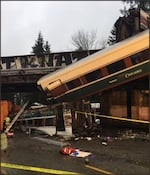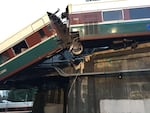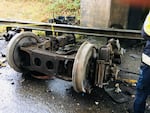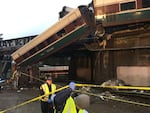The derailment of an Amtrak train Monday morning — which plummeted off an overpass while traveling more than twice the speed limit — has thrust a technology meant to prevent excessive speeds back into the national spotlight.
It’s called positive train control, or PTC.
The technology is meant to slow or stop speeding trains and override possible human error by initiating automatic braking. And for years, the National Transportation Safety Board has pushed for its implementation. But after railroads and freight companies complained about the complex nature of the undertaking, Congress extended the implementation deadline to 2018.
The latest derailment in DuPont, Washington, killed three people and sent around 100 others to the hospital.
Related: NTSB: Amtrak Train Going 80 MPH In 30 MPH Zone When It Derailed
At a news conference late Monday, NTSB board member Bella Dinh-Zarr confirmed Amtrak Train 501 should have been traveling at 30 mph in the curve where it crashed. It was instead moving at 80 mph.
“PTC would prevent types of accidents such as this,” Dinh-Zarr said. “Whether it would prevent this accident remains to be seen. We should remember that PTC can’t prevent every accident, but it does prevent certain types of derailments, overspeed accidents as well as incursions into work zones.”
Washington state and Oregon co-own Amtrak Cascades. Officials from the Oregon Department of Transportation said the Amtrak system is likely to meet the 2018 deadline. And Washington’s Gov. Jay Inslee said he will work to ensure the deadline is met in his state.
But Inslee also urged people to avoid speculating on the cause of the accident while an investigation is underway.
“There are one thousand unanswered questions about this right now,” Inslee told reporters Tuesday. “One of the questions is, could that speed control have made a difference? We don’t know that for sure right now.”
Technology safeguard
PTC is meant to override human error.
“It’s a backup to human beings making mistakes,” said Steven Ditmeyer, a rail expert who used to work with the Federal Railroad Administration.
The multi-pronged system incorporates GPS technology, trackside signals and digital radios that connect to rail line dispatch centers. Positive train control can be programmed to automatically track speed limit changes and can even apply a train's brakes.
Prompted by a deadly crash in Southern California in 2008 when a passenger train collided with a Union Pacific freight train, Congress mandated all major rail lines to use PTC. The changes were supposed to be met by 2015, but Congress later extended the deadline to 2018.
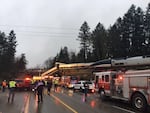
A Portland-bound Amtrak train derailed near Tacoma, Wash., Monday, Dec. 18, 2017.
Pierce County Sheriff's Department
The mandate was not popular among rail operators. They saw it as an unfair requirement that would burden the industry with expensive upgrades.
“Some of the resistance is cost,” said former FRA safety director George Gavalla, who stressed that the most common types of train accidents are prevented with PTC.
“For the rail lines, this is primarily a matter of investment,” he said.
As of March 2017, the Association of American Railroads reports freight railroads have spent $8 billion on PTC development and installation. Passenger trains have spent about $3.5 billion.
Status of PTC
Officials with the National Transportation Safety Board briefed the public on preliminary findings of the Amtrak derailment Tuesday afternoon.
A review of the train’s data recorder revealed that the emergency brake was automatically activated rather than initiated by the engineer.
Dinh-Zarr, with the transportation safety board, said the rail line where the derailment occurred did not have PTC installed, but rather a system called Centralized Traffic Control — or CTC.
CTC gives dispatchers some control but does not allow them to automatically slow trains the way PTC can.
Amtrak Train Derailment Location
The Amtrak train derailment on Dec. 18 occurred close to where the new Cascades route reconnects to the original route.
Data: US Dept. of Transportation, Open Street Maps, Amtrak / OPB
Dinh-Zarr also confirmed that two people were in the train cab at the time of the derailment: the engineer and a conductor who was undergoing training to become familiar with the new route.
All crew members aboard Amtrak Train 501 were hospitalized. Once they are able, those people will undergo extensive interviews with NTSB.
Federal transportation officials expect to be in the area for the next seven to 10 days as they complete their investigation.
Northwest News Network's Austin Jenkins contributed to this report.
Correction: This story has been updated to accurately state the name of CTC, Centralized Traffic Control.
